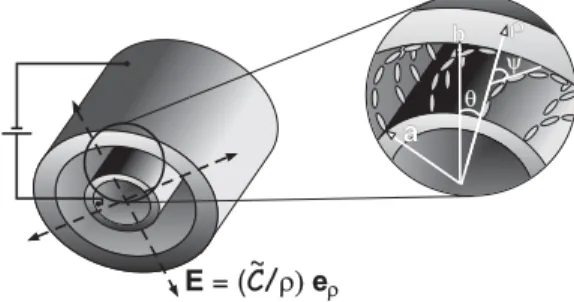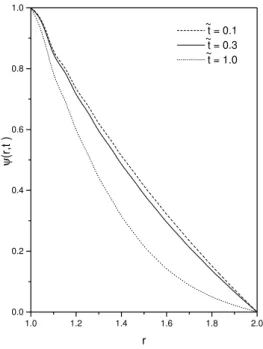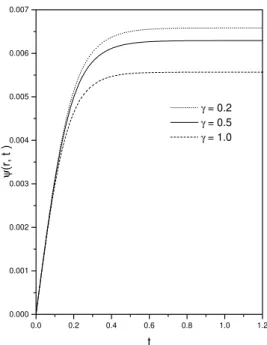Director profile of a nematic between two concentric cylinders with inhomogeneous boundary
conditions
C.A.R. Yednak1,2, E.K. Lenzi1,2,∗ and L.R. Evangelista1
1Departamento de F´ısica, Universidade Estadual de Maring´a Avenida Colombo, 5790-87020-900 Maring´a (PR), Brazil and 2Dipartimento di Fisica del Politecnico di Torino, Corso Duca degli Abruzzi 24, 10129, Torino Italia
(Received on 10 February, 2009)
The tilt angle profile in a nematic cell limited by two concentric cylindrical surfaces with inhomogeneous distribution of easy axes is investigated in the one-constant approximation. The results are presented in terms of the Green function approach by considering the strong anchoring case and the presence of an external electric field for small distortions.
Keywords: Liquid crystal; Nematic; Strong anchoring
1. INTRODUCTION
Systems that involve liquid crystal alignment between two concentric cylinders have been investigated in connection with the flexoelectric instability [1], with the stability analy-sis of the orientational profile [2], and the Fr´eedericksz tran-sition occurring in the absence of external electric field [3]. The starting point of these analysis was the original problem proposed by Meyer, solved in a special case by Parodi, and then discussed in the book by de Gennes [4]. Subsequently, the same problem was reexamined by Williams [5] by con-sidering that the elastic constants of splay and bend are dif-ferent, in the strong anchoring approximation. Very recently, the equilibrium problem for a nematic liquid crystal confined within two parallel eccentric cylinders with homeotropic an-choring on the lateral boundaries has been rigorously ana-lyzed by Rosso et al. [6] in the framework of a purely director approach. In general, problems dealing with the equilibrium orientational states of nematic liquid crystals are faced in the framework of the elastic continuum theory for liquid crys-talline materials. The basic principle of this theory is that the distorted state can be described by the directorn that is of unit length but can be of variable orientation, and represents the average molecular orientation. The equilibrium config-uration is the one minimizing the total free energy of the sample subjected to appropriate boundary conditions [7, 8]. The determination of the equilibrium director profile can be formulated in terms of boundary value problems [9]. The boundary value problem concerning the situation of strong anchoring on the boundaries corresponds to the Dirichlet’s problem, whereas the weak anchoring situation leads to the mixed Dirichlet - Neumann problem. On the other hand, the situation in which the easy axes characterizing the preferred surface alignment change direction continuously with time is relevant to investigate systems whose surfaces are covered with photopolymeric films [10]. In these systems, the ori-entational changes of the photochromic molecules promoted by incident light lead to remarkable changes in the molecu-lar orientation. In this direction, problems dealing with ori-entational dynamics and surface viscosity have also been in-vestigated by Mertely and Copic [11]. For this reason, in order to account for these characteristics of a nematic
sam-∗Electronic address:eklenzi@dfi.uem.br
ple confined between two cylinders, we face here a gener-alization of the model treated in Refs. [3, 5] by considering a system formed by inhomogeneous surfaces, i.e., by con-sidering that on each cylindrical surfaces the treatment has ensured a spatial distribution of the easy directions. Further-more, the present approach incorporates a time dependence in the distribution of easy axes on the surfaces, in the situ-ation of strong anchoring, which is a more difficult mathe-matical problem, but can represent a more realistic physical situation. In this manner, our analysis is quite general in the framework of the usual approximation of one-elastic con-stant; it takes into account an external field, directed along the radius of the cylinders, in the limit of small distortions. To face the dynamical reorientation problem in a complete manner it is necessary to take into account that the motion of the fluid is coupled with the fluid flow, i.e., to consider back-flow effects. Thus, besides playing an important role in the response of a nematic liquid crystal to an applied field, the molecular reorientation can generate a flow which in turn af-fect the reorientation [12, 13]. As underlined by Svensek and Zumer, there has been little or no work done in the backflow problems in severely confined geometry like the one we are considering in this work. This happens because, in this case, backflow is a consequence of the confinement. Therefore, the resulting flow patterns are quite complicated and even keeping the small distortion approximation as we are doing in the present analysis, the set of equations to be solved are hardly treatable in analytical manner [14]. For this reason, we restrict the present analysis to the very simplified case in which backflow effects are not taken into account. Any-way, the formalism presented here in terms of Green func-tion constitutes the appropriate mathematical framework to explore orientational field effects in nematic samples in con-fined geometries and can be extended to the situation of weak anchoring on the boundaries without significant difficulty.
2. THE MODEL
y q
+
b
a
E= (C/r)e E= (C/r)e
r
r
~
FIG. 1: Nematic sample limited by two concentric cylinders of ra-dius aandb. A uniform electric field is directed along a radial direction (normal to the cylinder axes,ez). The director angleψis also shown for a hypothetical distortion in the plane.
andez=k. To make the problem analytically treatable, we
assume small distortions and only splay-bend deformations. In this manner, our approach is valid for an applied field that is near the Fr´eedericksz threshold field. Notice, however, that the Fr´eedericksz transition in this system is actually a Fr´eedericksz-like transition when the starting configuration is a pure splay conformation, with a radial director. In the presence of a radial electric field, for a nematic liquid
crys-tal with a negative dielectric anisotropy (εa=εk−ε⊥<0), wherekand⊥refer to the direction ofn, a bend distortion can be found in the system only when the orientation on the boundaries is homeotropic [3]. On the contrary, for strong planar anchoring on the boundaries, a distortion can be found only for εa>0. Furthermore, a sample like the one we
consider could be prepared by firstly applying a very strong uniform field along the cylinder axes in order to achieve a homeotropic uniform alignment in a plane perpendicular to the axes of the cylinders. After that, an electric field in the radial direction should be considered. The electric field con-sidered here appears when the surfaces of the sample, lo-cated atρ=aandρ=b, are subjected to a constant potential difference. A typical situation is obtained when the surface
ρ=ais subjected to an electric potentialϕ=V/2 and the surfaceρ=b to an electric potentialϕ=−V/2. For this case, after solving the Maxwell equations, one obtains that E=
C
e/ρeρ withC
e =V/ln(b/a). In this manner, in the one-constant approximation, i.e.,K11=K22=K33=K, and by taking the external fieldE=C
e/ρeρinto account, the total elastic free energy per unit length along the zaxis is given byF[ψ(ρ,θ,t)] =
Z2π
0 dθ
Z b
a ρ
dρ
1
2K(∇ψ(ρ,θ,t)) 2
+ 1
2ρ2εa
C
e2ψ2(ρ,θ,t)
+
Z2π
0 dθ
Z b
a ρ
dρ
1
ρ2
2 ∂
∂θψ(ρ,θ,t) +1
. (1)
To analyze the dynamics of the orientation induced by the field we have to consider also a viscous torque. By mini-mizing Eq. (1), taking into account a viscous torque, we find that the dynamical evolution of the system is governed by the equation
∂
∂et ψ(r,θ,et) =∇
2ψ(r,θ,et)−γ2
r2ψ(r,θ,et), (2) written in a non-dimensional form by introducing a reduced coordindate r=ρ/(b−a), and a reduced timeet =t/τv,
where τv =λ(b−a)2/K is a viscous relaxation time for a sample in the shape of a slab of thickness b−a, when
λ is an effective viscosity coefficient of the liquid crys-tal [15, 16]. Furthermore, in Eq. (2),γ2=π2(E
0/Ec)2, where
E0=
C
e/(b−a)andEc2=π2K/εa(b−a)2corresponds to thethreshold field for the Fr´eedericksz transition in a sample of slab shape whose thickness is b−a, in the strong anchor-ing situation at the surfaces [7]. The last term in (1) does not enter in the Euler-Lagrange equation which contains the elastic term only through the Laplace-operator acting onψ. This equation needs to be solved subjected to the boundary conditions ψ(α,θ,te) =Φa(θ,et)andψ(β,θ,et ) =Φb(θ,et)
which are relevant to the strong anchoring situations, where,
for simplicity, non-dimensional quantitiesα=a/(b−a)and
β=b/(b−a)have been introduced. Notice that these bound-ary conditions account for inhomogeneous surfaces, i.e., the distribution of easy directions is spatially dependent. Fur-thermore, we have also generalized the calculation to incor-porate a time dependent distribution of easy axes. As pointed out above, a physical situation in which a time-dependent easy direction can be achieved can be found in systems formed by photochromic molecules that, under illumination, can undergo substantial change in their orientation, and, in turn, can produce a time dependent easy direction. The ini-tial condition, i.e., how the system was iniini-tially prepared, is
ψ(r,θ,0) =ψ0(r,θ). In order to analyze this problem, we first consider the absence of electric field and after we in-corporate this field in our calculation. In absence of electric field, Eq. (2) can be written as
∂
∂et ψ(r,θ,t) =∇
2ψ(r,θ,t),
(3)
ψ(r,θ,et) = −
Z 2π
0 dθ′
Z β
α dr
′r′
G
(r,θ,et;r′,θ′,0)ψ 0(r′,θ′)+
Zet
0 dt′
Z 2π
0 dθ′
"
βψ(β,θ′,t′) ∂
∂r′
G
r′=β
−αψ(α,θ′,t′) ∂
∂r′
G
r′=α
#
, (4)
where
G
=G
(r,θ,et;r′,θ′,t′)is obtained by solving∇2
G
(r,θ,et;r′,θ′,t′)− ∂∂et
G
(r,θ,et;r ′,θ′,t′)=1
rδ(r−r
′)δ(θ−θ′)δ(et−t′), (5)
with
G
(α,θ,et;r′,θ′,t′)=
G
(β,θ,et;r′,θ′,t′) =0 andG
(r,θ,et;r′,θ′,t′) =0, (6)foret<t′. The Green function which satisfies Eq. (5) may be obtained by using the eigenfunctions of the Sturm-Liouville problem related to the spatial operator. Thus, we obtain that
G
(r,θ,et;r′,θ′,t′) = −π 4∞
∑
n=1N
0nΨ0n(r,k0n)Ψ0n(r′,k0n)e−k 20n(et−t′)
− π 2
∞
∑
m=1∞
∑
n=1N
mnΨmn(r,kmn)Ψmn(r′,kmn)cos m(θ−θ′)e−k2mn(et−t′), (7)
with
Ψmn(r,kmn) = Jm(kmnr)Nm(kmnα)−J(kmnα)Nm(kmnr) and
N
mn =k2mn
h
(Jm(kmnα)/Jm(kmnβ))2−1
i, (8)
where Jm(x)and Nm(x)are the Bessel functions of first and
second species, andkmnare solutions of the eigenvalue
equa-tion
Jm(kmnβ)Nm(kmnα)−Jm(kmnα)Nm(kmnβ) =0.
The first term of Eq. (4) gives the dynamical evolution of the initial configuration of the system and the second term represents the “surface effect” on the first term. In particular,
if the system, depending on the choice of the external field and the boundary conditions, presents a stationary state, it is manifested by the second term of Eq. (4). In this manner, Eq. (4) shows how the surface plays an important role on the time dependent behavior of the director angle of this system. This result found for theψ(r,θ,et)in a confined region, i.e.,
α≤r≤β, may be extended to a semi-infinite region, i.e.,
α≤r<∞. For this case, it becomes
ψ(r,θ,et) =−
Z2π
0 dθ′
Z∞
α
dr′r′
G
e(r,θ,et;r′,θ′,0)ψ0(r′,θ′)−
Zet
0 dt′
Z 2π
0
dθ′αΦa(θ′,t′) ∂
∂r′
G
e(r,θ,et;r ′,θ′,t′)
r′=α
, (9) where
e
G
(r,θ,et;r′,θ′,t′) = − 1 2πZ∞
0
dk ke−k2(t−t′) Ψ(r,k)Ψ(r ′,k) J20(kα) +N20(kα)
− 1
π
∞
∑
m=1cos m(θ−θ′)
Z ∞
0
dk ke−k2(t−t′) Ψ(r,k)Ψ(r ′,k)
J2m(kα) +N2m(kα). (10)
It should be emphasized that while this limiting procedure poses no mathematical problem, it can lead to a physical
in-stabilities should make the director escape out of the eρ,eθ plane [18, 19].
Now, let us incorporate in our analysis the electric field, E=
C
e/ρeρ. Even in this more difficult situation, wecan obtain the exact solution for the profile of the tilt an-gle. In this scenario, Eq. (2) may also be analyzed by using the Green function approach as in the previous case and has as solution Eq. (4), with the Green function given by
G
(r,θ,et;r′,θ′,t′) = −π 4∞
∑
n=1f
N
0nΨe0n(r,k0n)Ψe0n(r′,k0n)e−k 20n(et−t′)
− π 2
∞
∑
m=1∞
∑
n=1f
N
mnΨmne (r,kmn)Ψmne (r′,kmn)cos m(θ−θ′)e−kmn2 (et−t′), (11)
with
e
Ψmn(r,kmn) = Jξm(kmnr)Nξm(kmnα)−Jξm(kmnα)Nξm(kmnr) and f
N
mn =k2mn
h
Jξm(kmnα)/Jξm(kmnβ)
2
−1
i, (12)
ξm =pm2+γ2, and the eigenvalues k
mn determined by
equation Jξm(kmnβ)Nξm(kmnα)−Jξm(kmnα)Nξm(kmnβ) =0. It is interesting to note that Eq. (11) has formally the same aspect of Eq. (7) and the difference is essentially in the eigen-functionΨmne (r,kmn), which for this case manifests the
influ-ence of the electric field.
1.0 1.2 1.4 1.6 1.8 2.0 0.0
0.2 0.4 0.6 0.8 1.0
~ ~ ~
~
t = 0.1 t = 0.3 t = 1.0
ψ
(r,t )
r
FIG. 2: Behavior ofψversusris illustrated in the absence of ex-ternal field for typical values ofetby considering, for simplicity, the initial conditionψ0(r,θ) =0,α=1,β=2, and the boundary con-ditionsΦa(θ,t) =1 andΦb(θ,t) =0.
1.0 1.2 1.4 1.6 1.8 2.0 0.0
0.2 0.4 0.6 0.8 1.0
~ ~ ~
~
t = 0.1 t = 0.3 t = 1.0
ψ
(r, t )
r
FIG. 3: Behavior ofψversusris illustrated in the absence of ex-ternal field for typical values ofet by considering, for simplicity, the initial condition ψ0(r,θ) =0, α=1, β=2, and the
bound-ary conditionsΦa(θ,t) =Φ0e−δt, withΦ0=1 andδ=1/τv, and Φb(θ,t) =0.
In Figs. 2-5, some particular behaviors of the complete tilt angle distribution of Eq. (4) are exhibited for illustrative pur-poses. In Figs. 2-3, the radial dependence is shown for the initial conditionψ0(r,θ) =0, for specific times and differ-ent boundary conditions. In particular, in Fig. 3, we have assumed a time dependent (periodic) easy direction on the inner cylindrical surface. In Fig. 4, ψ(r,θ,t˜) at the posi-tionr= (α+β)/2 (which coincides with the middle point between the two cylinders) is shown as a function of the field strengthγfor two limiting situationst=0 andt=∞
in the molecular orientation of the sample. Notice that on the boundaries the easy direction is uniform and planar (Φa(θ,t) =Φb(θ,t) =π/2), and for ˜t=0 the entire sample has this orientation. For large times, the field destroys the planar orientation, as expected ifεa>0, and the orientation at the middle point tends to be the homeotropic one. In Fig. 5, the time dependence of the tilt angle is shown in a particular position (r=2.5) for specific values of the field strength,γ. As expected, for relatively large times there is a saturation in the value of the tilt angle. The sample tends to a saturated distorted orientation, because we are assuming two different easy direction on the boundaries.
0.0 0.2 0.4 0.6 0.8 1.0 1.40
1.42 1.44 1.46 1.48 1.50 1.52 1.54 1.56 1.58
8
t = t = 0
~
ψ
(r, t )
r
FIG. 4: Behavior ofψversusγis illustrated for two limiting situa-tionst=0 andt=∞(stationary situation) by considering, for sim-plicity,α=1,β=2,r=1.5, the initial conditionψ0(r,θ) =π/2, the boundary conditionΦa(θ,t) =Φb(θ,t) =π/2.
3. DISCUSSION AND CONCLUSIONS
We have worked out the time dependent boundary value problem leading to the determination of the equilibrium di-rector profile in a liquid crystalline sample confined between two concentric cylindrical surfaces. To present an analysis as general as possible for this kind of problem, we have also considered the presence of an external field and a space and time dependence boundary conditions. In principle, this
sit-uation could be physically relevant for liquid-crystalline sys-tems confined between surfaces that are inhomogeneous and have a space and time distribution of easy directions. A sce-nario in which the easy axes change direction continuously, even if difficult to experimentally realize, can be found in
0.0 0.2 0.4 0.6 0.8 1.0 1.2 0.000
0.001 0.002 0.003 0.004 0.005 0.006 0.007
γ = 0.2 γ = 0.5 γ = 1.0
~
ψ
(r, t )
t
FIG. 5: Behavior of Eq. (4) versusetis illustrated for typical values ofγby considering, for simplicity, the initial conditionψ0(r,θ) =0,
r=2.5,α=1/3,β=4/3, and the boundary conditionsΦa(θ,t) = 1/100 andΦb(θ,t) =1/200.
those systems whose surfaces are covered with photopoly-meric films. In these systems, the orientational changes of the photochromic molecules promoted by incident light can lead to remarkable changes in the molecular orientation. The same formalism may also find applications in a diffusive pro-cess in the presence of an adsorption phenomenon at the in-terfaces [20, 21]. For this case, time dependent boundary conditions may be used to represent the dynamical process occurring between the bulk and the surfaces.
ACKNOWLEDGMENTS
E.K. Lenzi and L.R. Evangelista are especially thankful to the Brazilian Council of Research (CNPq), for continuous funding through a Research Productivity Grant, and to Coor-denadoria de Aperfeic¸oamento de Pessoal de N´ıvel Superior (CAPES), for funding C. A. R. Yednak.
[1] I. V. Kotov, M. V. Khazimullin, A. P. Krekhova, Mol. Cryst. Liq. Cryst.366, 2737 (2001).
[3] D. R. M. Williams and A. Halperin, Phys. Rev. E48, R2366 (1993).
[4] P. G. de Gennes and J. Prost,The Physics of Liquid Crystals, (Pergamon, Oxford, 1993).
[5] D. R. M. Williams, Phys. Rev. E50, 1686 (1994).
[6] R. Rosso, E. G. Virga, and S. Kralj, Phys. Rev. E74, 061703 (2006).
[7] G. Barbero and L. R. Evangelista,An Elementary Course on the Continuum Theory for Nematic Liquid Crystals, (World Scientific, Singapore, 2001).
[8] I. W. Stewart,The Static and Dynamical Continuum Theory of Liquid Crystals, (Taylor and Francis, London, 2004). [9] C. A. R. Yednak, R. N. Igarashi, E. K. Lenzi, and L. R.
Evan-gelista, Phys. Lett. A358, 31 (2006).
[10] L. T. Thieghi, R. Barberi, J. J. Bonvent, E. A. Oliveira, J. A. Giacometti, D. T. Balogh, Phys. Rev. E67, 041701 (2003). [11] A. Mertelj and M. Copic Phys. Rev. Lett.81, 5844 (1998); see
also references therein.
[12] S. M. Chen, T. C. Hsieh, and R. P. Pan, Phys. Rev. A43, 2848 (1991).
[13] Z. Zou, N. A. Clark, and T. Carlsson, Phys. Rev. E49, 3021 (1994).
[14] D. Svensek and S. Zumer, Continuum Mech. Thermodyn.14, 231 (2002).
[15] C. A. R. Yednak, F. C. M. Freire, E. K. Lenzi, and L. R. Evan-gelista, Phys. Rev. E72, 042701 (2005).
[16] S. Chandrasekhar, Liquid Crystals, (Cambridge Univeristy Press, Cambridge, 1977).
[17] M. P. Morse and H. Feshbach,Methods of Theoretical Physics, (McGrawHill, New York, 1953).
[18] F. Bethuel, H. Brezis, B. D. Coleman, and F. H´elein, Arch. Rat. Mech. Anal.118, 149 (1992).
[19] P. J. Barratt and B. R. Duffy, J. Phys. D: Appl. Phys.29, 1551 (1996).
[20] R. Rossato, M. K. Lenzi, L. R. Evangelista, and E. K. Lenzi, Phys. Rev. E76, 03212 (2007).


